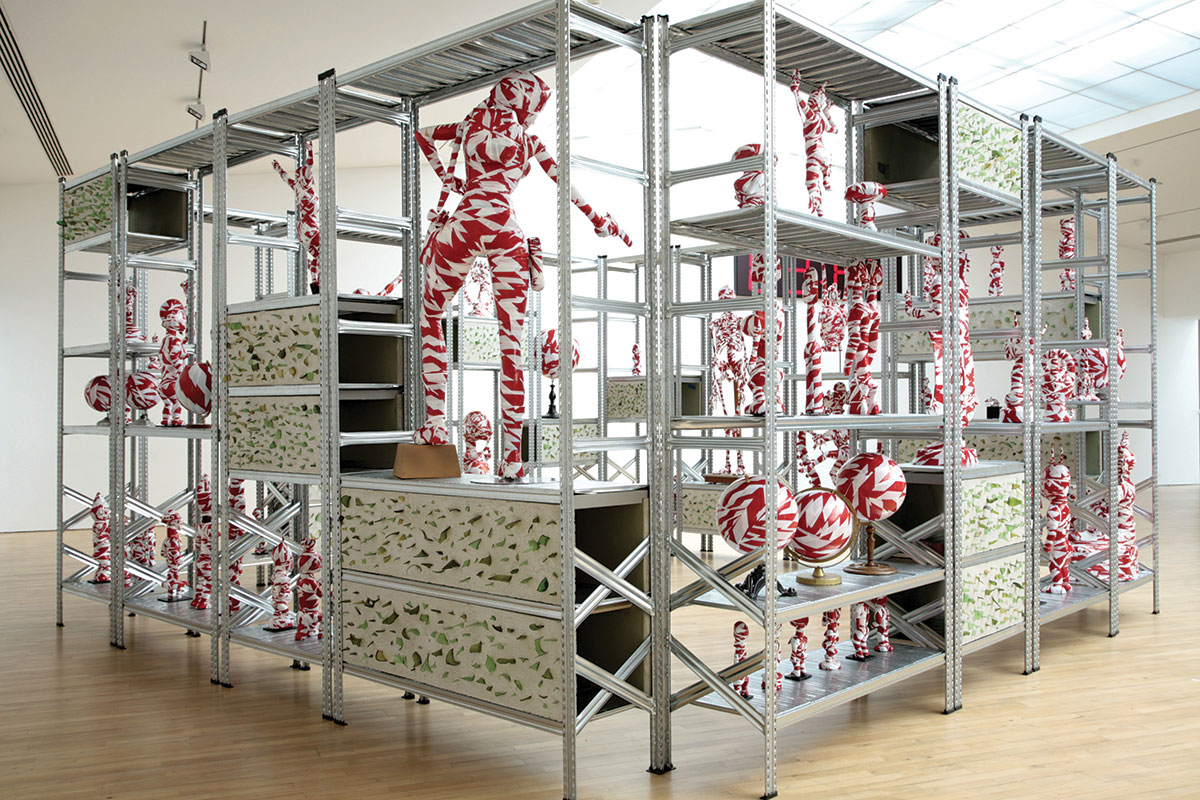Deeply marked by by his experiences growing up in Apartheid South Africa, Kendell Geers’ art is often read as an artistic response to the the journey he made reinventing himself and his identity through art, transforming the illigitimacy of his cultural heritage into something noble. His artistic practice is however much more than solely political with its layers of ethical, aesthetic and spiritual interrogation as he explores the boundaries of what is permitted and not in the social construction of identity, power and language. Over the last two decades Geers has carved a unique role for the artist in a society that has all but forgotten the transformational power of the arts.
Using a wide variety of media, art and historical references, strategies of provocation and disruption with an unwavering faith in true change, Kendell Geers communicates with an uncompromising poetic and spiritual language that is nothing less than a force of nature. His works are both physically and visually engaged, using colour, materials and symbols that signal danger and yet also invite transformation into baptisms by fire. The pervasiveness of violence in Western culture has given rise to a banality that masks its own existence in our quotidian lives, but trans-placed into the realm of art, the violence is trans-figured into an ethical question that implicates the very foundations of aesthetics.
This transformation of violent objects like a police batons into art recalls the violence implicit in art historical images such as the Crucifixion or Gericault’s “Raft of the Medusa” and Goya’s “Third of May.” Through the prism of Geers’ visionary process, languages, materials and images are used to question the duality and double bind in structures of power, for every border has two sides, one that excludes and the other that unites. The danger tape and broken glass we find in “Kode-X” for instance mark sacred objects with a political function as church and state become flip sides of the same golden coin.
For Geers all modern materials possess a double meaning and multiple readings, according to their social, political, religious and cultural functions, attracting and repulsing at the same time in different contexts. This raw but poetic way of communicating happens as an invitation to engage rather than a dictatorial manner, for each spectator reads the works through their own identity and individual experience.
We find this delicate balance of danger and seduction, attraction and repulsion in a work like “Master Mistress of my Passion,” a beautiful virginal white Madonna like figure pierced with green shards of glass. As fragile as she is dangerous, she is beautiful to look at but impossible to touch. The broken glass shards that seem to emanate from within her flesh are an ancient universal technique that was used to protect the Villa Medici in Rome as well as countless suburban homes around the world. The Shakespearian sonnet that lends the work its title, refers to the poet’s secret love and Geers proposes that every border masks a fragile secret truth of human insecurity.
This reference to literature is a common practice in Geers’ work, as the codes and transformation of history and the inversion of structures of power are grist for his mill. A poet no less, he plays with words in his titles, creating multiple meanings and exploring contra-dictions with layers of reading that hide even more layers of reading. Geers believes that at the Biblical origin of language, the confusion of tongues and Tower of Babel, lies the simple truth that language is a gift from God, but that the gift is a double edged sword that is as much a curse as it is divine. Given this sacred understanding of the word, he uses four letter words like magical charms.
The four letter word is a portrait of his working class origins, and of raw energy that marks a class socially and economically forced to live in conditions that by nature exclude poetry and metaphor. The four letter word is used as a sword that cuts away social flesh down to the ethical bone speaking with a tongue as sharp as flint stone. Most famous of the four letter words is “fuck,” a word that Geers explains is defined positively or negatively according to its use for “Fuck me” is an invitation to love but “fuck you” a declaration of war and Geers performs both simultaneously.
In the artist’s hands the four letter words become a mantra of transformation and elevate their profanity to a sacred end. Repeated like a chainmail, the visual mantra adorns “Cadavre Exquis,” a first generation cast from the original Nike de Samothrace in the Louvre. As with “Master Mistress of my Passion” and so many other works, it is not without coincidence that Geers has decided to embody the divine female, to embrace a female centred sacred space. The wounded female form is resurrected and leads towards another understanding of the possibilities of art. The title refers to a method used by Surrealists to collectively embody a single image as each person created a part of an image unaware of what the others had done. The collective unconscious that Geers invites into his collaboration includes not only the spirits of artists like André Breton or Marcel Duchamp but also Nike, the ancient Greek goddess herself. Art he says, is nothing without “magick.”
The painted bronze sculpture “In advance of a broken arm” bears the same title as a work by Duchamp dating from 1915. We recognise the very natural pointing index finger that small children might use to express their desires before mastering a language or the ancient symbolic gesture of John the Baptist as well as the key to understanding the alchemical motto “as above, so below.” This sacred gesture of the right hand points to the profane gesture on the left hand of the “mano figo,” a popular talisman to ward off the evil eye. Language is revealed here to be as symbolic as it is verbal for history creates habit that in turn gives rise to common socio-political and religious understanding.
Geers uses various tools to engage with his audience, encouraging them to reflect upon multiple readings and contradiction. The neon scultpure “Manifest” quotes the blue neon spiral line from a 1967 Bruce Neuman scupture “The true artist helps the world by revealing mystic truths,” but Geers has transformed art history to now recast the question as “What do you believe in ?” The answer he adds is subjective, leaving it in your hands to answer for yourself.









